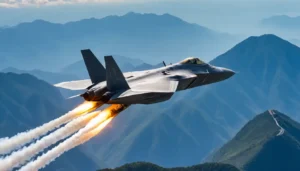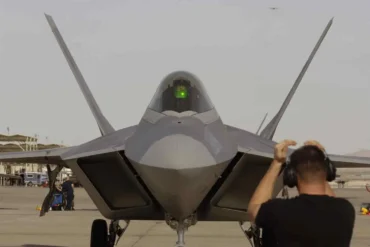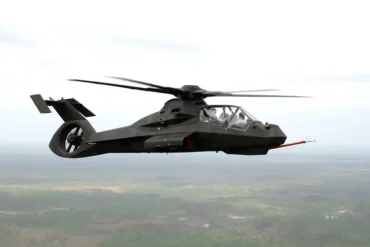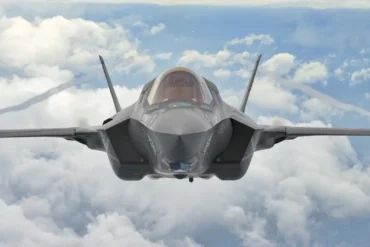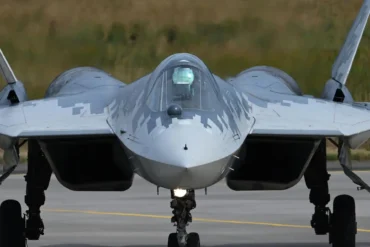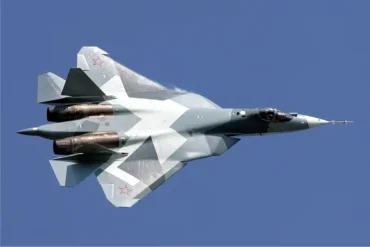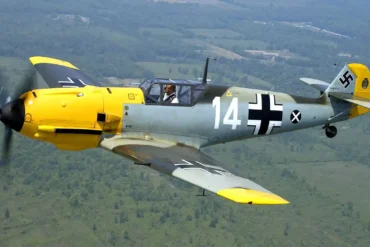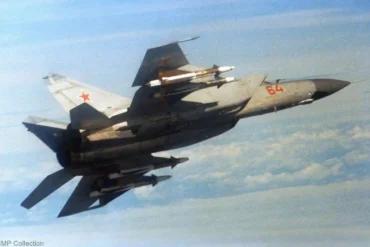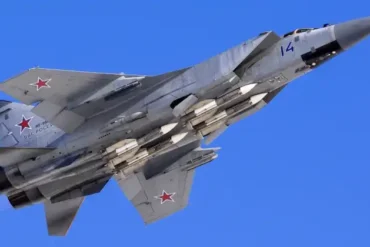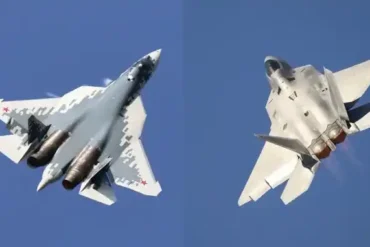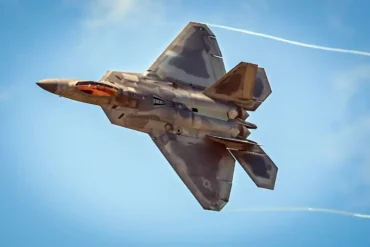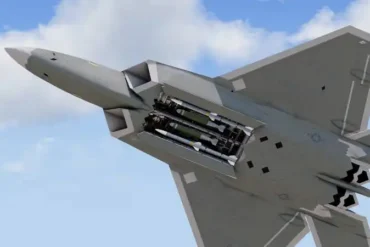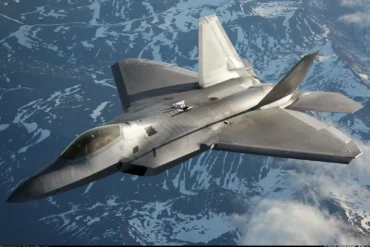The details of the Chinese J-20, a 5th-generation stealth fighter, are pretty mysterious. But over the years, China’s military has shared some useful bits of info. Even with all the secrecy, we can pick up on some key things to understand what kind of threat this aircraft might pose.
How the Chinese J-20 Stacks Up Against the US Air Force F-22
At first glance, the J-20’s sleek design makes you do a double take. It’s drawn attention in US Congressional reports and Pentagon essays. Some see it as closely copying US 5th-gen stealth technology. Those concerns come through in Pentagon reports, showing worries about China taking US military tech.
The J-20’s stealthy shape has a blended-wing body, rounded fuselage, and what looks like an internal weapons bay without external pylons. While it’s often compared to the F-35, its twin engines are more like the F-22. But its elongated dual-wing fuselage makes it stand apart from current F-22 or F-35 designs, giving it a unique 5th-gen profile.
The J-20 is huge, nearly five meters longer than the F-22. Key differences, like maximum takeoff weight and fuel capacity, highlight the distinct builds of these impressive aircraft. The J-20 stretches 23 meters long, way more than the F-22’s 18.9 meters. That extra length, plus bigger fuel tanks, gives the J-20 way more range. Its 4,166-gallon capacity dwarfs the F-22’s 2,400 gallons, meaning the J-20 has a range nearly 3,000 km farther.
That big range difference matters strategically, putting Taiwan within reach of the J-20 but not the F-22. However, it’s important to note the F-22 can go over 1,864 miles with non-stealthy external fuel tanks added. But that slows it down and hurts air combat ability.
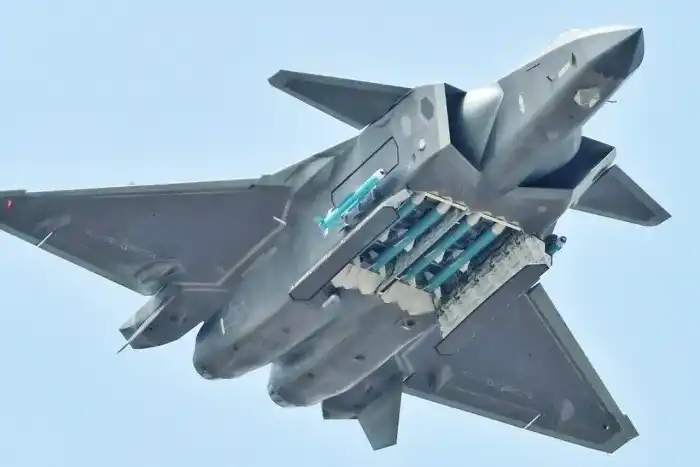
Despite its length and double-wing design, the J-20 may not be as nimble as the F-22. So it’s less likely to compete for air superiority. But once over a target, the J-20’s huge payload makes it a fearsome weapon-delivery platform. That payload advantage is why it’s slower (1,333 knots) than the speedy F-22 (1,963 knots).
Payload shows another contrast, with the J-20 able to take off with 27,998 pounds of weapons, way more than the F-22’s 3,915 pounds. For air-to-air combat, that means the F-22’s agility and speed could potentially outflank and take out a J-20. That depends on factors like weapon range, sensors, and targeting tech.
Detecting the J-20 before it spots an F-22 or F-35 is key. Precision guidance and air-to-air weapon efficiency add complexity. Advanced networking and AI computing are crucial.
Figuring out the superior aircraft relies on those unknowns. The US Air Force and Navy should focus on intercepting J-20s before they’re near targets, using the F-22’s proven dominance. Whether the F-22 keeps its edge or is becoming obsolete, even after 25 years, drives ongoing upgrades aiming to keep it flying until 2060.
The upcoming 6th-gen Pentagon aircraft, moving quick but secret, looks set to beat the F-22 in many ways. But the Air Force doesn’t plan to retire the F-22 anytime soon. Experts consistently highlight the F-22’s unmatched traits – speed, maneuverability, overall air superiority. The Air Force and Lockheed Martin are focused on major high-tech upgrades to improve weapons, speed, targeting, range, radar, and stealth.
Over the past five years, Lockheed and the Air Force collaborated on the 3.2b software upgrade. A fleet-wide effort, it significantly improved computing, sensors, weapons guidance. Notably, it enhanced the AIM-9X and AIM-120D air-to-air weapons, boosting range, guidance, precision.
The Lockheed-Air Force weapons upgrade uses a Block II AIM-9X variant with new fuse and ignition tech, improving ground handling and adding “lock-on-after-launch”. That brings beyond-line-of-sight targeting through a new datalink, per Raytheon.
With off-boresight targeting, the AIM-9X uses an imaging infrared sensor. With the Joint Helmet Mounted Cueing System or modern sights, pilots easily guide the missile by looking at targets. The 3.2b upgrade also boosts the AIM-120D, an advanced medium-range air-to-air missile. Raytheon data shows its “fire and forget” active radar guidance. Upgrades increase range, add GPS navigation, inertial sensors, two-way datalinks – overall better performance.
Interestingly, the F-22 was originally just a high-speed air superiority fighter. But lately it has taken on roles like close air support, advanced sensing, even aerial quarterback. As a QB, it shares targeting intel and real-time data with other assets – 4th-gen jets, command centers, drones.
To support this, the Air Force now links the F-22 and F-35 data both ways. Earlier LINK 16 was one-way only. Companies like Northrop Grumman developed radios like the 550 Freedom. Using advanced frequencies, they connect F-22s and F-35s while preserving stealth.
The F-22 saw its first combat over Iraq against ISIS in 2014. This showed its close air support capabilities. Its speed and agility could let it track and hit ground targets with advanced precision-guided weapons. While resilience to small arms isn’t fully known, it would likely rely on speed, targeting and agility.
The F-22 could use supercruise, reaching Mach speeds without afterburner. This extends high-speed flight and improves maneuverability for air-ground and air-air missions.
The successful performance led discussions about restarting F-22 production. The original plan was much bigger than the roughly 169 now. But after long debate, the DoD and Congress chose not to restart manufacturing, perhaps because early 6th-gen work had begun.
References:
- China Has Stolen US Military Secrets to Create Formidable J-20 Knockoff of America’s F-22 Raptor, Say Experts
- China Reveals J-20 Stealth Fighter’s Missile-Carrying Capability
- F-35A Lightning II – U.S. Air Force Fact Sheet
- F-22 Raptor – U.S. Air Force Fact Sheet
- China’s J-20 and Russia’s Su-57 Aren’t Quite 5th Generation Fighter Jets
- Lockheed Martin F-35 Lightning II – Wikipedia
- Lockheed Martin F-22 Raptor – Wikipedia
- Lockheed Martin F-22 Raptor – Lockheed Martin
- Air Force General Hints Future Fighter Fleet Won’t Include F-22
- R&D Tops Procurement in Air Force’s 2024 Budget Proposal
- China Is Mad: The U.S. Air Force Just Deployed F-22 Raptors to the Pacific
